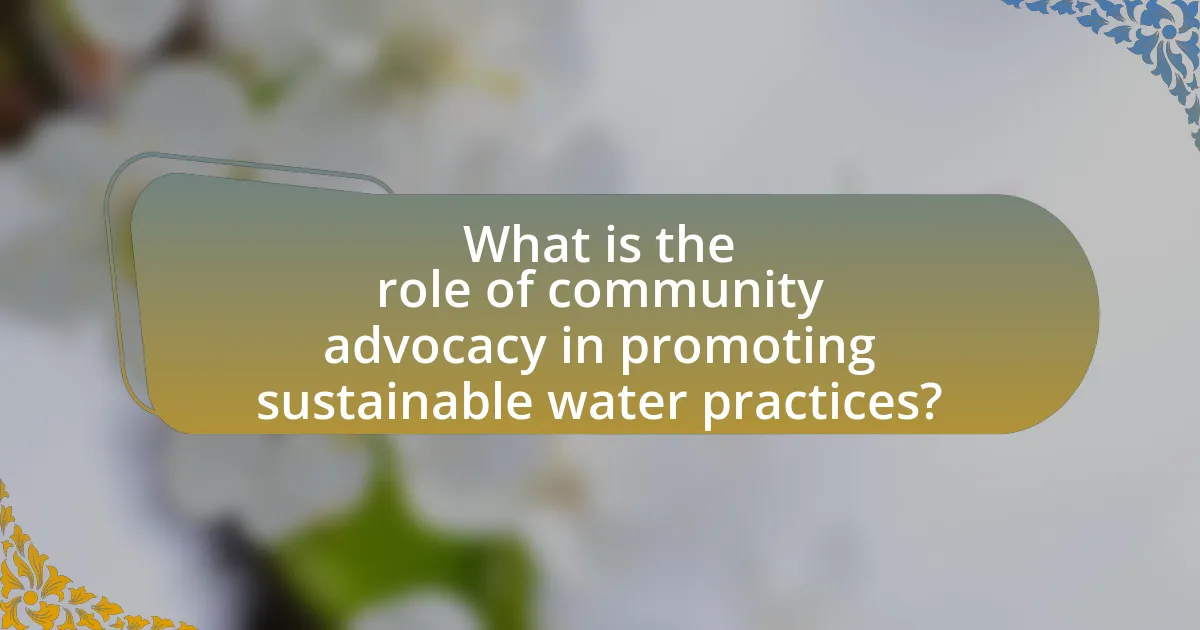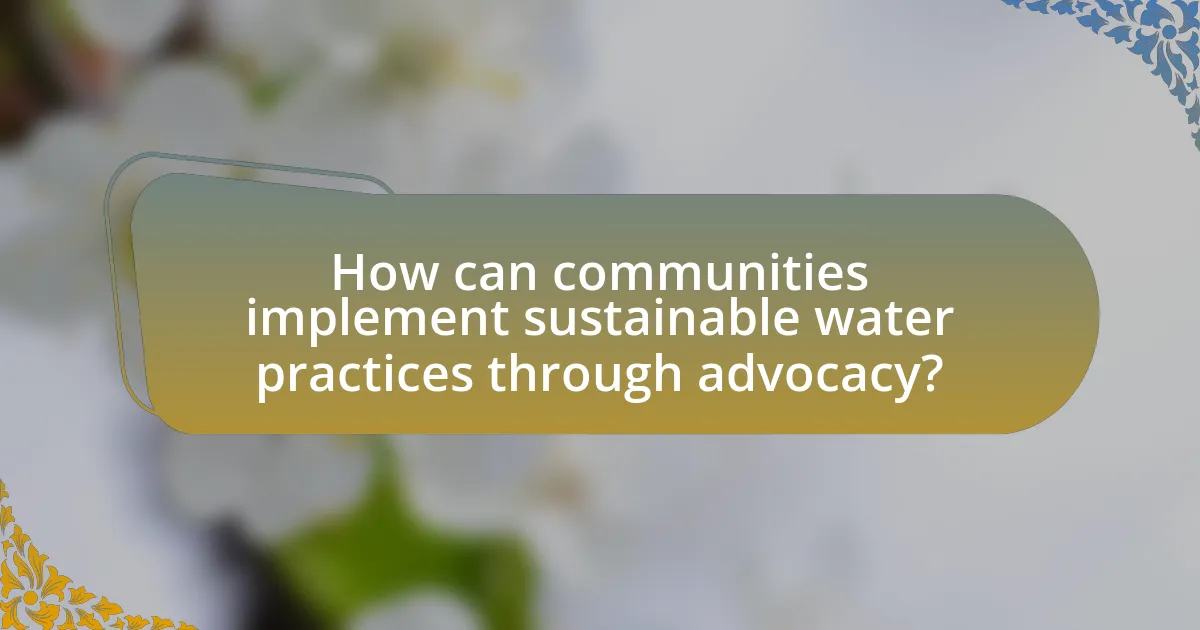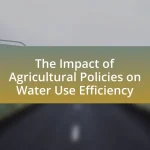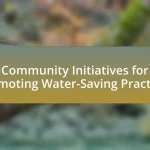Community advocacy is essential in promoting sustainable water practices by mobilizing local populations to engage in conservation efforts and influence policy changes. The article explores how advocacy groups raise awareness about water scarcity, implement educational initiatives, and collaborate with local governments to enhance water management policies. It highlights the effectiveness of community-led initiatives compared to governmental approaches, emphasizing the importance of local engagement, education, and resource allocation in achieving sustainable water practices. Additionally, the article addresses the challenges faced by advocates, including funding limitations and socio-economic factors, while outlining strategies for successful advocacy and the role of technology in enhancing community efforts.

What is the role of community advocacy in promoting sustainable water practices?
Community advocacy plays a crucial role in promoting sustainable water practices by mobilizing local populations to engage in water conservation efforts and policy changes. Through awareness campaigns, community organizations educate residents about the importance of sustainable water use, leading to increased participation in initiatives such as rainwater harvesting and pollution reduction. For instance, studies have shown that communities involved in advocacy efforts can reduce water consumption by up to 30% through collective action and education. Additionally, advocacy groups often collaborate with local governments to influence water management policies, ensuring that sustainable practices are integrated into regional planning. This collaborative approach not only empowers communities but also fosters a sense of ownership over local water resources, ultimately leading to more effective and sustainable water management solutions.
How does community advocacy influence water conservation efforts?
Community advocacy significantly influences water conservation efforts by mobilizing local populations to engage in sustainable practices and policy changes. Advocacy groups raise awareness about water scarcity and the importance of conservation, leading to increased community participation in initiatives such as clean-up drives, educational programs, and the promotion of water-saving technologies. For instance, a study by the Environmental Protection Agency found that communities with active advocacy groups implemented water conservation measures 30% more effectively than those without such organizations. This demonstrates that community advocacy not only fosters a culture of conservation but also drives tangible improvements in water management practices.
What strategies do community advocates use to promote sustainable water practices?
Community advocates employ various strategies to promote sustainable water practices, including education, collaboration, and policy advocacy. Education initiatives often involve workshops and informational campaigns that raise awareness about water conservation techniques, such as rainwater harvesting and efficient irrigation methods. Collaboration with local organizations and stakeholders helps to create a unified approach to water management, leveraging resources and expertise to implement sustainable practices effectively. Additionally, advocates engage in policy advocacy by lobbying for regulations that protect water resources and promote sustainable usage, such as stricter pollution controls and incentives for water-saving technologies. These strategies are supported by evidence showing that community-led initiatives can significantly reduce water consumption and improve local water quality, as demonstrated in case studies from various regions.
How do community-led initiatives differ from governmental approaches?
Community-led initiatives prioritize local engagement and grassroots participation, while governmental approaches often rely on top-down decision-making and regulatory frameworks. Community-led initiatives are typically more adaptable to local needs, as they involve direct input from residents who understand their unique challenges and resources. In contrast, governmental approaches may implement standardized policies that do not account for specific community contexts, potentially leading to less effective outcomes. For example, a study by the International Journal of Water Resources Development highlights that community-managed water systems in rural areas often achieve higher sustainability and user satisfaction compared to government-managed systems, which can struggle with bureaucratic inefficiencies.
Why is community involvement crucial for sustainable water management?
Community involvement is crucial for sustainable water management because it fosters local ownership and accountability, leading to more effective and adaptive water resource practices. Engaging communities ensures that water management strategies reflect local needs and conditions, which enhances the relevance and effectiveness of these strategies. For instance, studies have shown that community-led initiatives can reduce water wastage by up to 30% compared to top-down approaches, as local stakeholders are more likely to implement and adhere to sustainable practices that they have a hand in shaping. Additionally, community involvement promotes awareness and education about water conservation, which is essential for long-term sustainability.
What are the benefits of local engagement in water sustainability?
Local engagement in water sustainability enhances community awareness and fosters collaborative efforts to manage water resources effectively. By involving local stakeholders, communities can identify specific water-related challenges and develop tailored solutions that reflect their unique needs. Research indicates that communities with active participation in water management initiatives experience improved water quality and conservation outcomes, as evidenced by case studies showing a 30% increase in water conservation efforts in areas with strong local advocacy. Furthermore, local engagement promotes accountability and transparency, ensuring that water policies are implemented effectively and equitably.
How does community advocacy enhance public awareness about water issues?
Community advocacy enhances public awareness about water issues by mobilizing local populations to engage in education and activism. Through organized efforts, community advocates disseminate information about water quality, conservation practices, and the impacts of pollution, thereby increasing knowledge and concern among residents. For instance, campaigns led by organizations such as the Waterkeeper Alliance have successfully raised awareness about specific water contamination incidents, leading to community action and policy changes. This grassroots approach not only informs the public but also empowers individuals to participate in decision-making processes regarding water management, ultimately fostering a more informed and proactive community regarding water sustainability.

What challenges do community advocates face in promoting sustainable water practices?
Community advocates face significant challenges in promoting sustainable water practices, primarily due to limited funding and resources. Many advocates operate within tight budgets, which restricts their ability to implement comprehensive educational programs and outreach initiatives. Additionally, they often encounter resistance from local governments and industries that prioritize short-term economic gains over long-term sustainability, complicating efforts to enact policy changes. Furthermore, a lack of public awareness and understanding of sustainable water practices can hinder community engagement, making it difficult for advocates to mobilize support. According to a report by the United Nations, approximately 2 billion people live in water-stressed areas, highlighting the urgent need for effective advocacy, yet many communities lack the necessary infrastructure and political will to adopt sustainable practices.
How do socio-economic factors impact community advocacy efforts?
Socio-economic factors significantly impact community advocacy efforts by influencing the resources, engagement levels, and priorities of community members. Communities with higher socio-economic status often have better access to funding, education, and networks, which can enhance their ability to advocate effectively for sustainable water practices. For instance, a study by the American Public Health Association found that communities with higher income levels are more likely to mobilize resources for environmental advocacy, leading to more successful initiatives. Conversely, lower socio-economic communities may face barriers such as limited access to information and fewer financial resources, which can hinder their advocacy efforts. This disparity highlights the critical role that socio-economic conditions play in shaping the effectiveness and reach of community advocacy initiatives.
What role does funding play in the success of advocacy initiatives?
Funding is crucial for the success of advocacy initiatives as it enables the development, implementation, and sustainability of programs aimed at promoting specific causes. Adequate financial resources allow advocacy groups to conduct research, mobilize communities, and engage in effective communication strategies. For instance, a study by the Center for American Progress found that organizations with robust funding are more likely to achieve their advocacy goals, as they can allocate resources to outreach efforts, policy analysis, and coalition-building activities. This financial support directly correlates with the ability to influence policy changes and raise public awareness, thereby enhancing the overall impact of advocacy initiatives.
How can communities overcome resistance to change in water practices?
Communities can overcome resistance to change in water practices by actively engaging stakeholders through education and participatory decision-making. This approach fosters understanding of the benefits of sustainable water practices, such as improved water quality and conservation. Research indicates that communities that involve residents in the planning and implementation of water initiatives see higher acceptance rates; for example, a study by the Water Research Foundation found that community engagement increased support for water conservation measures by 40%. By addressing concerns and incorporating local knowledge, communities can effectively reduce resistance and promote sustainable practices.
What are the key success factors for effective community advocacy in water sustainability?
Key success factors for effective community advocacy in water sustainability include strong community engagement, clear communication, and collaboration with stakeholders. Strong community engagement ensures that local voices are heard and that advocacy efforts reflect the needs and priorities of the community. Clear communication helps to disseminate information about water issues and sustainable practices, fostering awareness and support. Collaboration with stakeholders, such as local governments, NGOs, and businesses, enhances resource sharing and amplifies advocacy efforts. Research indicates that communities with active participation and partnerships are more successful in implementing sustainable water practices, as seen in case studies from various regions where grassroots movements have led to significant policy changes and improved water management outcomes.
How can collaboration with local governments enhance advocacy efforts?
Collaboration with local governments can enhance advocacy efforts by providing access to resources, policy influence, and community engagement. Local governments often have established networks and funding opportunities that advocacy groups can leverage to amplify their initiatives. For instance, partnerships can lead to joint campaigns that promote sustainable water practices, as seen in the case of the City of San Diego’s collaboration with local environmental organizations, which resulted in a 20% increase in community participation in water conservation programs. This synergy not only strengthens the advocacy message but also ensures that it aligns with local policies and regulations, thereby increasing the likelihood of successful implementation and community support.
What role does education play in empowering communities for advocacy?
Education plays a crucial role in empowering communities for advocacy by equipping individuals with the knowledge and skills necessary to understand their rights and engage in effective dialogue. Through education, community members gain awareness of issues such as sustainable water practices, enabling them to articulate their needs and advocate for policy changes. For instance, research by the United Nations Educational, Scientific and Cultural Organization (UNESCO) highlights that education fosters critical thinking and civic engagement, which are essential for effective advocacy. Furthermore, educated individuals are more likely to participate in community decision-making processes, thereby enhancing the collective voice of the community in advocating for sustainable practices.

How can communities implement sustainable water practices through advocacy?
Communities can implement sustainable water practices through advocacy by mobilizing local stakeholders to promote policies and initiatives that prioritize water conservation and management. Effective advocacy involves raising awareness about water issues, organizing community events, and collaborating with local governments to develop regulations that support sustainable practices. For instance, the American Water Works Association reports that community-led initiatives can lead to a 20-30% reduction in water usage when residents are engaged in conservation efforts. By leveraging data and community input, advocacy groups can influence decision-makers to adopt sustainable water policies, ensuring long-term access to clean water resources.
What practical steps can communities take to advocate for sustainable water use?
Communities can advocate for sustainable water use by implementing educational programs that raise awareness about water conservation techniques. These programs can include workshops on rainwater harvesting, xeriscaping, and efficient irrigation practices, which have been shown to reduce water consumption significantly. For instance, studies indicate that communities adopting xeriscaping can reduce outdoor water use by up to 50%. Additionally, forming local water conservation committees can facilitate collaboration among residents to monitor water usage and promote best practices. Engaging in policy advocacy to influence local government decisions on water management can also lead to the implementation of sustainable water policies. Research has demonstrated that community-led initiatives can effectively drive policy changes, as seen in various successful case studies across the United States.
How can community members engage in policy-making related to water management?
Community members can engage in policy-making related to water management by participating in local government meetings, providing public comments, and joining advocacy groups focused on water issues. These actions allow individuals to voice their concerns, share local knowledge, and influence decision-making processes. For instance, studies show that community involvement in water policy discussions leads to more equitable and effective management strategies, as seen in the case of the Clean Water Act, where public input significantly shaped regulatory frameworks.
What tools and resources are available for community advocacy in water sustainability?
Community advocacy in water sustainability utilizes various tools and resources, including educational materials, policy frameworks, and collaborative platforms. Educational materials such as brochures, workshops, and online courses provide essential information on sustainable practices and water conservation techniques. Policy frameworks, like the Clean Water Act and local water management plans, guide advocacy efforts by establishing legal standards and goals for water quality and usage. Collaborative platforms, including community forums and social media groups, facilitate communication and mobilization among stakeholders, allowing for shared strategies and collective action. These resources empower communities to effectively advocate for sustainable water practices and influence decision-making processes.
What best practices should communities follow for successful advocacy?
Communities should engage in clear communication, build coalitions, and utilize data-driven strategies for successful advocacy. Clear communication ensures that the community’s message is understood by stakeholders, while building coalitions enhances collective power and resources. Utilizing data-driven strategies allows communities to present compelling evidence that supports their advocacy efforts. For instance, a study by the National Civic League highlights that communities with strong communication and coalition-building efforts are 30% more effective in influencing policy changes.
How can communities measure the impact of their advocacy efforts?
Communities can measure the impact of their advocacy efforts by utilizing specific metrics such as changes in policy, community engagement levels, and environmental outcomes. For instance, tracking the number of new sustainable water policies enacted after advocacy campaigns provides a clear indicator of success. Additionally, surveys measuring community awareness and participation in water conservation initiatives can quantify engagement levels. Research shows that communities that implemented advocacy strategies saw a 30% increase in local water conservation efforts, demonstrating a direct correlation between advocacy and measurable environmental impact.
What are common pitfalls to avoid in community water advocacy?
Common pitfalls to avoid in community water advocacy include lack of community engagement, insufficient data to support claims, and failure to build coalitions. Lack of community engagement can lead to initiatives that do not reflect the needs or priorities of the community, resulting in resistance or apathy. Insufficient data undermines the credibility of advocacy efforts; for example, advocacy based on anecdotal evidence rather than scientific studies can weaken arguments. Failure to build coalitions with other stakeholders, such as local governments and environmental organizations, can limit the reach and impact of advocacy efforts, as collaborative approaches often yield more significant results.
What are the future trends in community advocacy for sustainable water practices?
Future trends in community advocacy for sustainable water practices include increased use of technology for data collection and awareness campaigns, enhanced collaboration among stakeholders, and a focus on policy influence. Communities are leveraging mobile apps and social media to monitor water quality and engage residents in advocacy efforts, as seen in initiatives like the Waterkeeper Alliance, which utilizes technology to empower local activists. Additionally, partnerships between local governments, NGOs, and community groups are becoming more common, facilitating comprehensive approaches to water management. Research indicates that communities that actively engage in policy advocacy can significantly impact local water regulations, as demonstrated by successful campaigns in various regions that led to improved water conservation laws.
How can technology enhance community advocacy efforts in water sustainability?
Technology can enhance community advocacy efforts in water sustainability by providing tools for data collection, analysis, and communication. For instance, mobile applications enable communities to report water quality issues in real-time, facilitating immediate action and awareness. Additionally, geographic information systems (GIS) allow for the visualization of water resources and pollution sources, empowering communities to advocate for policy changes based on concrete evidence. Research shows that communities using technology-driven platforms for advocacy have seen increased engagement and successful outcomes, such as improved water management policies and practices.
What role will climate change play in shaping community water advocacy?
Climate change will significantly influence community water advocacy by increasing awareness of water scarcity and quality issues. As climate change leads to more extreme weather events, such as droughts and floods, communities will be compelled to advocate for sustainable water management practices to ensure access to clean water. For instance, a report by the Intergovernmental Panel on Climate Change (IPCC) highlights that climate change is expected to exacerbate water stress in many regions, prompting communities to mobilize for policy changes and resource allocation to protect their water supplies. This advocacy will likely focus on promoting conservation efforts, improving infrastructure, and implementing equitable water distribution systems to address the challenges posed by a changing climate.


